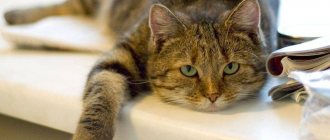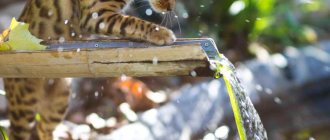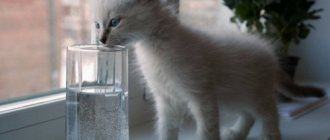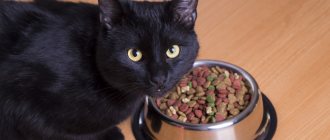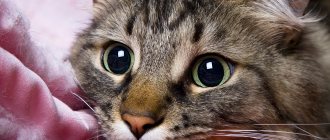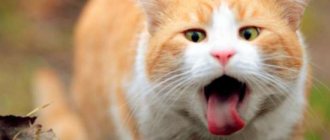The appearance of a small kitten in the house is a big responsibility for the owner. It is necessary to provide the animal with proper nutrition and proper care. Creating comfortable conditions includes mandatory monitoring of any even the slightest changes in health.
If a cat refuses food and water, this is a sign that not everything is fine with the pet. It is necessary to understand how much fluid an animal consumes per day is normal, and in what cases it is necessary to seek help from a veterinarian. Prolonged dehydration negatively affects the functioning of the entire body and each cell in particular.
Fluid norm for caudates
Only a small number of owners know the daily fluid intake for their pet. Despite this, this indicator is very important and is calculated individually based on a number of criteria.
Volume by mass and activity
On average, the recommended volume is 20-40 ml per 1 kg of weight for adult animals (that is, a 5-kilogram cat will drink about 150 ml, that is, half a glass). For kittens, these numbers increase 2-3 times.
In addition to age and body weight, activity level affects the final value. The norm of mustachioed couch potatoes is lower than that of energetic lovers of regular walks on the street and frequent runs around the house.
Exceeding the norm is permissible within 15-20% of the total volume. If your pet drinks more, there is every reason to suspect something is wrong.
How to determine how much water your pet drinks
The easiest way is to use a measuring cup. Fill it to the full mark and pour the contents into a bowl. At the end of the day, pour the rest back into the glass and compare it with what you had. The resulting difference is the desired value.
If there are several cats, they will have to be temporarily isolated from each other. Otherwise, the experiment will not be indicative. To increase reliability, take several measurements on different days and calculate the arithmetic average.
Why the cat doesn't drink water - non-dangerous reasons
If a cat refuses water, then first of all it is necessary to find out the reason for the loss of their interest. If there are no alarming symptoms and the usual behavior is maintained, the problem lies in something harmless. In this case, you can deal with it yourself.
Don't like the bowl
The animal may not like the material and shape of the product. Plastic bowls absorb odors and quickly accumulate bacteria, giving their contents an unpleasant taste. Metal has a slightly different problem. It reflects light rays, so the cat may be frightened or confused by the glare.
A bowl that is too narrow is also rarely popular. It injures the vibrissae. Also, we must not forget about the presence of dirt. Drinking stagnant liquid is a rather dubious pleasure.
I don't like the watering place
Not all animals like to drink in the kitchen. If the problem lies in the wrong location, then you will have to guess the ideal location through trial and error.
Neglect of the bowl may also be due to the location of the feeder being too close. Because of this proximity, food particles constantly end up in the water. It is also worth considering that predators prefer to share the place where they catch and eat prey with their “watering hole.”
Too noisy rooms, as well as close proximity to cleaning products and a cat litter box, are also not welcome. For this reason, the living room and bathroom with toilet are the most dubious options for placing a drinking bowl.
Gets enough water from feed
Pieces of spider meat jelly and canned pates for cats contain up to 80% of the daily moisture requirement. There are no problems when feeding “natural”, since internal reserves are regularly replenished with the following products:
- liquid porridge;
- dairy products;
- fish, meat and offal;
- gravies and broths;
- fruit and vegetable juices.
Animals that do not eat dry food need less. They drink less often and less, but in their case it is completely natural.
Drinks in a place unnoticed by the owners
Sometimes the problem is the presence of external sources. A mustachioed pet can guerrilla in the bathroom, aquarium and even in the toilet.
Some animals lick a freshly washed floor with great enthusiasm, but it is better to wean off this habit immediately. Otherwise, the cat risks being poisoned by the detergent.
Their love for taps is explained by the fact that in natural conditions wild cats try to avoid stagnant bodies of water. Unlike rivers and lakes with underground springs, such “watering places” contain a lot of dirt and microbes.
Coming out of anesthesia
Generally, recovery from anesthesia is accompanied by loss of appetite, but sometimes the administered drug provokes a short-term (up to 12 hours) refusal to drink.
A temporary lack of food is harmless to the body, but you should be careful with water. Most often, interest in her appears within 2-3 hours after returning home. Before the usual activity appears, the pet is fed strictly from a syringe, since if it is consumed independently, it may choke.
Why the cat doesn't drink water: dangerous reasons
If the cat does not drink water from the bowl at all and you are completely sure that there are no foreign sources, pay attention to his well-being. The presence of accompanying symptoms is a good reason to contact a veterinarian, indicating the presence of pathology.
Oral diseases
Any inflammation and neoplasms on the mucous membranes make swallowing difficult. In this case, thirst remains, so the pet can sit at the bowl with a sad expression and chew only on the healthy side. A similar picture occurs with pain in the teeth.
In addition to behavioral changes, the presence of dental diseases can be determined by the appearance of the teeth and soft tissues. If dark plaque, redness, ulceration and an unpleasant odor appear, the cat should be scheduled for examination at a veterinary clinic.
Gagging
During attacks of nausea and immediate vomiting, drinking is very problematic. If your pet bends over in another attack, then first of all it needs to be checked for symptoms of poisoning:
- increased heart rate;
- hard breath;
- dilated pupils;
- trembling of limbs;
- drowsiness and apathy;
- loss of balance;
- blanching of mucous membranes;
- nosebleeds;
- temperature change;
- stool disorder.
The clinical picture depends on the type of poison, its quantity and the strength of the cat’s immunity. It is not necessary to wait for all of the above. Even 2 symptoms are enough to contact a veterinarian.
Other possible causes of vomiting include foreign objects, infections, helminthiasis and various diseases of the internal organs. With the help of gagging, the body tries to get rid of toxins, as well as push out an object stuck in the throat.
Hydrophobia, including rabies
Hydrophobia, or hydrophobia, develops due to spasms of the larynx. Thirst persists, but the sick animal consciously refuses water, fearing to choke.
The main cause of hydrophobia is rabies. Infection can be identified by a sudden change in behavior, perverted appetite and profuse drooling. Symptoms develop progressively.
The main danger of rabies in cats is the lack of specific treatment. The infected person also poses a danger to everyone around him.
If alarming symptoms appear, it must be isolated and transferred to veterinarians or employees of the city trauma center. If the pet is vaccinated, then if a second dose of the vaccine is administered in a timely manner, it can survive.
Convulsions and paralysis
Convulsions and paralysis do not develop on their own. They are always provoked by concomitant diseases.
Both disorders affect the cat's coordination and behavior. Involuntary muscle contraction while drinking leads to hydrophobia, and if the paws fail, the ability to freely move to the kitchen disappears.
Convulsions and paralysis are similar in initial symptoms. You can suspect something is wrong by the pet’s aloofness (hiding in secluded corners) and unusual aggression when trying to pick it up or just pet it.
When to go to the vet
- Dry and warm nose. In a healthy animal it is cold and damp.
- Body temperature is above 37-38. It is a sign of infection in the body.
- Diarrhea and vomiting, like fever, are a symptom of infection.
- Deterioration of condition.
What to do if your cat doesn't drink water
If the cat does not drink water from the bowl at all, then it is not so difficult to understand what to do. To do this you need to find out the reason:
- Wrong material and bowl size. Buy a new glass or ceramic water bowl, making sure that it will not damage your pet's whiskers.
- Dissatisfaction with the watering place. Place containers throughout your home to find what works best. If your animal gravitates towards running water, then it makes sense to purchase a drinking fountain.
- Lack of cleanliness. Wash the bowl daily, but without using detergent. Remember that the water should be changed every day, and in the hot season - twice a day.
- I don't like the container itself. Don't get stuck on one option. Try attracting your pet with their own cup, container or tall bucket.
- Consequences of anesthesia. The situation will normalize on its own when the drug is completely out of the body.
- I don't like the water itself. You should not give cats running water - choose filtered or bottled liquid. Otherwise, there is a risk of not only refusing to drink, but also kidney disease.
For diseases of the oral cavity, it is recommended to use warm water heated to 30 degrees. Lower temperatures increase pain, and higher temperatures burn the mucous membranes. Despite the effectiveness of this method, if a disease is suspected, the animal should still be shown to a veterinarian.
How can this problem be solved?
First we need to discuss water quality. Cats will always prefer fresh, clean water to stagnant or cloudy water. Therefore, the water should be changed daily or even several times a day - it will only be better.
We must not forget that the water in the bowl can become contaminated not only from dust or the ingress of some foreign objects, but also from cat saliva, which gets there in sufficient quantities after the first drink.
If a dog lives in the house with a cat, then it will probably drink from the same bowl, which can also affect the cat’s attitude towards such water. In this case, you should block the dog's access to the cat's drinking bowl. For example, a bowl can be placed on a windowsill.
One of the unsuccessful options for a water container is a double bowl into which both food and water are poured. In bowls with a similar device, food particles often fall into the water, contaminating it. The same thing happens when the water bowl is too close to the food bowl. Also, you should not use the same bowl for eating and drinking; in other words, the drinking bowl must be a separate container.
Care should be taken to ensure that the water does not contain any impurities and does not have any repulsive odors. Perhaps you should refrain from using various detergents and cleaning products, since they leave odors that the cat will not necessarily like. Although it can be argued that she will not like them for sure.
Should you force your pet to drink?
The need for forced drinking depends on the reason for refusing to drink and general well-being. In the absence of pathologies, such pressure has the opposite effect. It is much better to try the recommendations described above.
If your pet recovers from anesthesia, then he will have to be fed from a syringe without a needle for about a day. Otherwise, there is a risk of dehydration. The same applies to the listed disorders, with the exception of rabies.
Dehydration
A disease that occurs due to the loss of large amounts of water.
Symptoms:
- Arrhythmia
- Dry skin
- Decreased appetite
- Viscous saliva
- Lethargy and lack of activity
- Constipation or diarrhea
- The animal begins to hide in corners
- Increase and decrease in temperature
Treatment: When you notice the first signs of dehydration in your cat, you need to try giving him fluids yourself.
If the animal is vomiting, you can inject 10 ml of sodium chloride solution, this will help significantly improve its condition. But the most necessary thing is to go to a veterinary clinic.
Prevention:
- Monitor your cat's availability of water.
- In addition to dry food, also provide wet food.
- Do not allow the animal to overheat in the sun.
Cats need water just like people. When you get a pet, you must treat it with full responsibility, because its life and health depend only on you.

